How To Make Yogurt
This post may contain affiliate links. See my disclosure policy.
Whether you’re making regular or Greek yogurt, it’s time to learn How to Make Yogurt! It’s incredibly easy, requires virtually no prep work and the outcome will amaze you: Wonderfully thick, creamy, luxuriously delicious yogurt! This homemade yogurt recipe is SO good and SO easy, you’ll NEVER need to buy store-bought again!
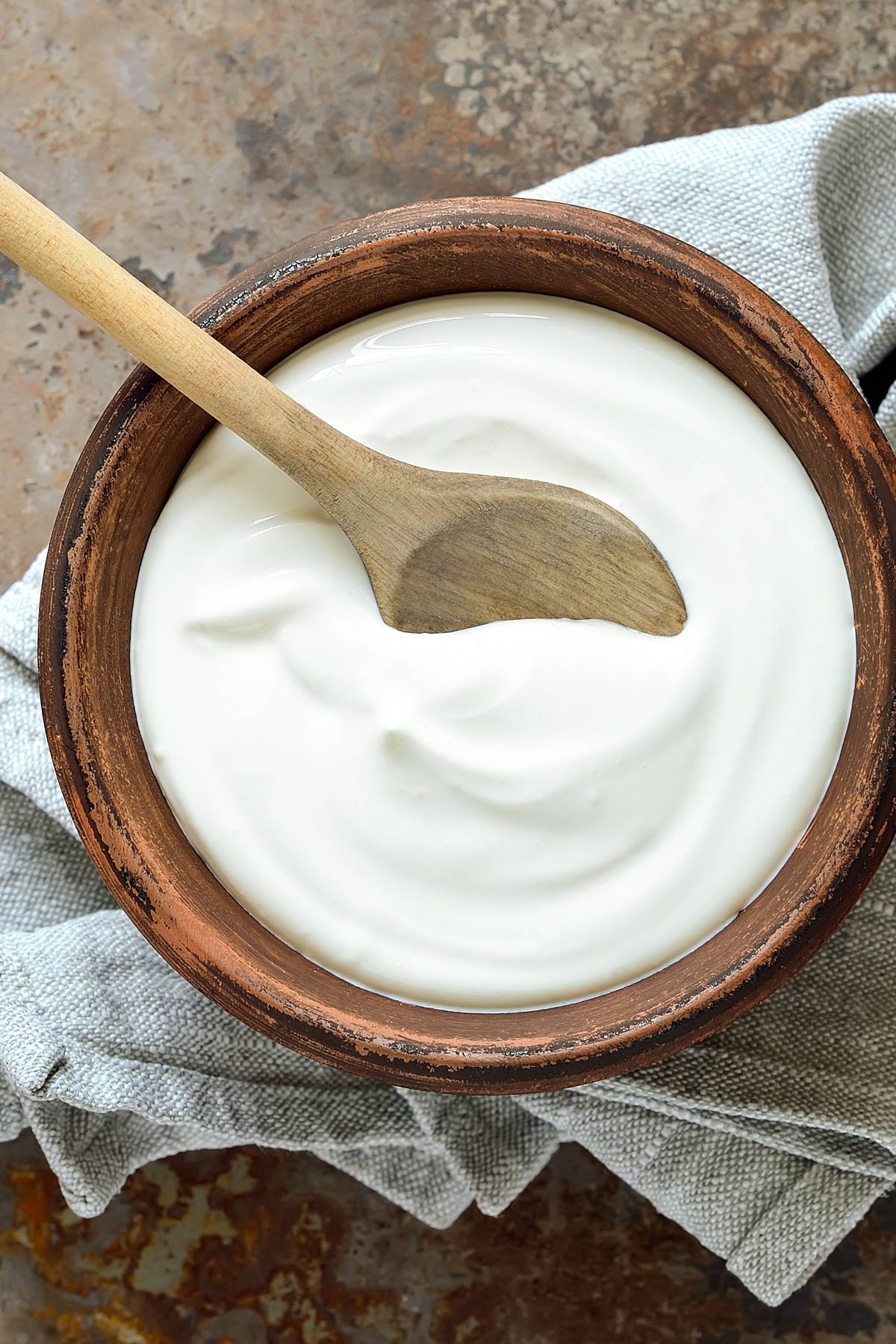
How long does it take you to pour a gallon of milk into a slow cooker? That’s how much prep time is involved in making this gloriously thick, rich, creamy Easy Homemade Yogurt recipe! And you have full control over its thickness – we’ll show you how to make Greek yogurt or regular yogurt, your choice!
Why Should I Make My Own Yogurt?
There are several advantages to making your own yogurt: It tastes better, has a better texture, is MUCH CHEAPER, and it’s MUCH HEALTHIER than store-bought because it has a MUCH HIGHER PROBIOTIC CONTENT. Really, it’s a complete win-win!
What Kind of Milk Should I Use to Make Yogurt?
For the thickest, creamiest yogurt we recommend whole milk but you can also use 2% and even skim milk.
How to Make Greek Yogurt
The difference between making regular and Greek yogurt simply comes down to how long you strain it. More on that in the recipe below.
Homemade Yogurt Ingredients and Equipment
- Milk
- Plain yogurt (as a starter culture)
- Cheesecloth
- Thermometer
- Pot or Slow Cooker
- Colander
Besides milk you’ll need some plain yogurt as a starter culture for your initial batch. Then you can use yogurt from that batch for your next batch and so on. There is no need to buy a special starter culture, all you need is plain yogurt. The plain yogurt will act as a starter culture to introduce healthy bacteria/probiotics to your homemade yogurt. It is essential that the yogurt you use has live cultures in it. Most grocery stores sell plain yogurt with live cultures but just be sure to check the label on the container confirm that it has l. bulgaricus and s. thermophilus in it.
You will also need some cheesecloth to strain the yogurt (trust me, it’s much easier than it may initially sound). I use and recommend this cheesecloth because it’s 100% unbleached cotton, is high grade, is very durable for multiple uses, and you get a ton of it. Overall it’s the best value I have found for the quality.
You’ll also need a thermometer. Heating the milk to right temperature and then reducing it to the right temperature are both critical to the success of your yogurt.
The other item you’ll need is either a slow cooker or a large, heavy stock pot and a colander for straining.

Slow Cooker vs Stovetop
You can use either with great success and the choice is entirely up to you.
Slow Cooker Method
Pros: The heating process is slow and gentle so there is no risk of scorching the milk and having to throw it all out. Plus it’s hands free and the milk can heat up over the course of a few hours while you’re doing other things.
Cons: It takes a lot longer to heat up the milk than if you’re using a pot. But that’s only a disadvantage if you’re in a hurry.
Stovetop Method
Pros: It’s much quicker than using a slow cooker. The milk heats up faster and then all you have to wait for is for it to cool back down and then set.
Cons: It requires your constant attention and as the milk gets hotter it requires constant stirring in order to prevent the milk from burning (and it can burn very easily if you’re not paying attention).
You can see that both have their pros and cons and it purely comes down to personal preference. I use and like both methods but generally use my slow cooker/crock pot more often because of the hands-free convenience of plugging it in and going about my daily tasks. Any crock pot or slow cooker will do the job. I use and love my Hamilton Beach Stay or Go 7 Quart Slow Cooker.
Do I Have to Bring the Temp to 180 F if I’m Using Pasteurized Milk?
Virtually every yogurt-making recipe will tell you to heat the milk to 180 degrees F before bringing it back down to 110 degrees F to inoculate it with a starter culture. The question you may ask yourself is, if I’m using pasteurized milk already do I need to heat it to 180 degrees or can I just skip that step?
Here’s what I’ve learned: Heating it to 180 degrees isn’t for the purpose of killing unwanted bacteria as much as it is for creating a thick texture. The heat changes the structure of the proteins in the milk and enables it to thicken into yogurt. I wanted to test that for myself and heated the milk to just a little over 110 degrees, added the starter culture, and proceeded from there. It hardly thickened at all. But when I heat it to 180 degrees, then let it cool to 110 degrees before adding the starter, it thickens up beautifully.
What is Whey?
That yellowish liquid that’s left over after you strain the yogurt….that’s called whey. When making homemade yogurt, you’ll always end up with some whey as a by-product. The longer you strain the yogurt, the thicker it will get, the more whey it will yield. If you strain it to full capacity for an extra thick Greek yogurt, you’ll end up with about 8 cups of whey, but every batch will be different.
Whey is milk minus the fats and solids. It’s basically water with lactose and protein. And it’s the protein that’s the valuable ingredient here. Milk contains two types of protein, casein and whey. Most of the casein ends up in the yogurt and the whey is in the liquid by-product.
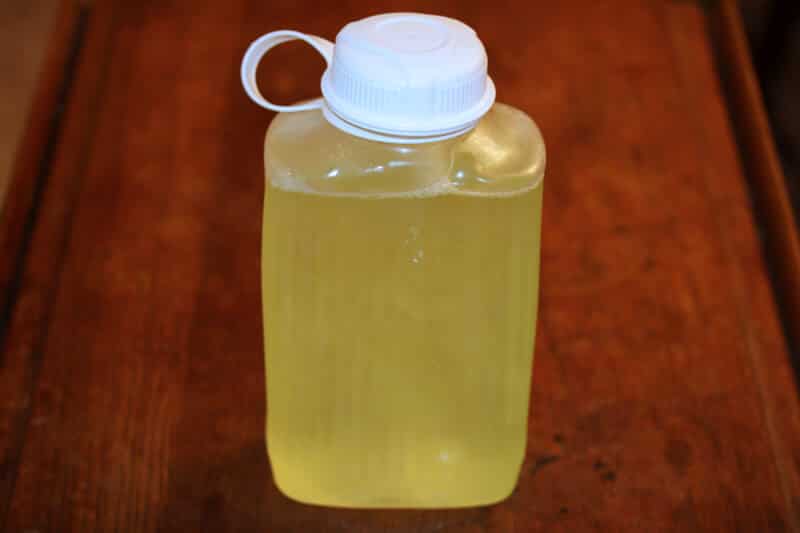
How to Use Leftover Whey
I’m so glad you asked! Whey is a great source of protein and is used in powdered form in protein shakes and protein bars. But how can you this leftover liquid whey? Here are a few ideas:
- Use it in place of water when you’re making broth or soup for an extra rich broth.
- Use it in place of water for baking bread or pastries.
- Add it to your smoothies of an extra protein boost.
- If you have a vegetable garden, use it lower the pH level of your soil if you’re growing things that prefer soil with a higher acidity level, like tomatoes.
Can You Freeze Whey?
Yes, it can be frozen for up to 6 months.
Can I Make a Smaller Batch of Yogurt?
This recipe calls for a gallon of milk because this yogurt will keep for a good 2 weeks in the fridge, giving you plenty of time to finish it off. (Note that a gallon of milk won’t yield a gallon of yogurt. It will yield about 2 quarts of yogurt depending on how long you strain it.) If however you would prefer to make less you can absolutely cut the recipe in half and use a half gallon instead. Just be sure to remember to reserve enough of the yogurt to act as the starter for your next batch.
How Much Protein and Calories Are in My Yogurt?
This is a question I get frequently. Calorie count and protein content will depend on how much whey was removed in the straining process and there really isn’t a way to measure that. Even calories are hard guess because through the straining process the end product is much more condensed that the original milk product. The best we can do is estimate.
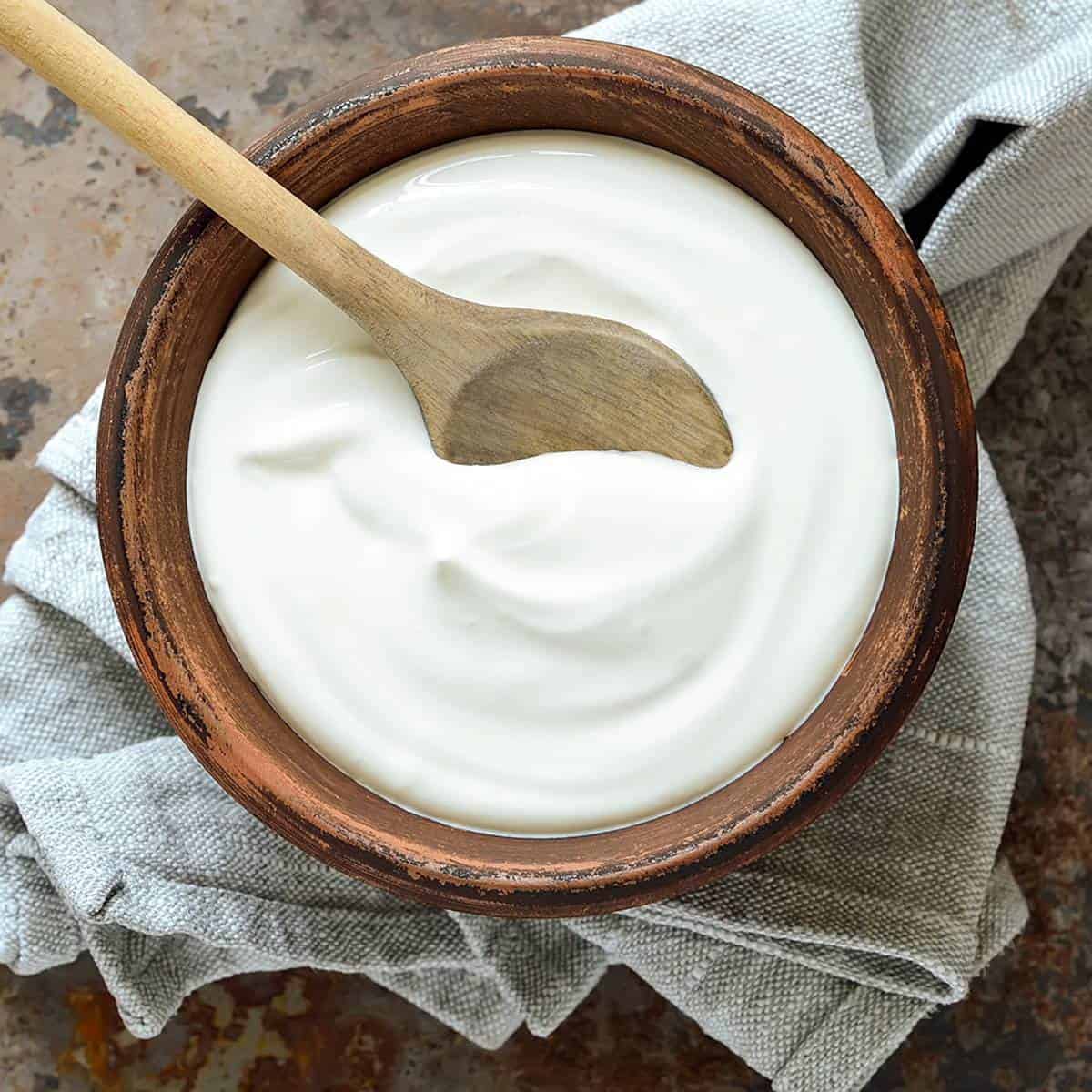
Homemade Yogurt Troubleshooting
“My yogurt didn’t set and I have yogurt soup!”
There may be an occasion or two when your yogurt doesn’t set properly. I’ve made probably close to 50 batches and fortunately it’s only happened to me twice but it was nevertheless disappointing. Many factors can be at play for a failed batch, anything from the first step to the last. If you’ve done everything right and have followed every step correctly from start to finish, all I can say is that the yogurt-making process involves fragile live bacteria and sometimes, well, they have a mind and will of their own. And if you’re using store-bought yogurt as your starter culture, it may claim to have live bacteria that is…no longer live. The only thing to do is try again with a new batch. But just because it failed turning into yogurt doesn’t mean you can’t still enjoy it.
Don’t throw out the “soup!”
Throughout Europe and other parts of the world you can get a variety of delicious plain and flavored yogurt drinks. You can drink your yogurt milk and you’ll still be benefitting from those healthy probiotics. Add some honey or flavored syrups or blend in some berries or fruits of your choice and enjoy it in smoothie form!
Ways to Enjoy Yogurt
There are so many ways you can enjoy your homemade yogurt. Here are just a few ideas:
- Add fresh berries or cut up fresh fruits to enjoy with your yogurt along with a sprinkle of cinnamon and/or a drizzle of honey or maple syrup for a healthy breakfast or snack.
- Make parfaits with fresh fruit and granola.
- Blend it with fresh or frozen fruit or with nuts, peanut/cashew/almond butter, chocolate, etc. to make smoothies.
- Add other ingredients and seasonings to use as a sandwich, toast or bagel spreads.
- As the base of a savory dip for oven-baked chips, bread or raw veggies.
- As the base of a sweet dip for fresh fruits or toasted cinnamon pita strips.
- Use it in place of mayonnaise for ranch dressing and other creamy dressings.
- Make homemade tzatziki sauce.
- Replace sour cream and buttermilk with yogurt in baked goods like cakes, muffins, pancakes or our sweet potato pie.
- Make yogurt fruit popsicles.
- Use it in place of sour cream for things like tacos, enchiladas and burritos.
- Use it in place of mayonnaise for egg, tuna, chicken salad and potato salad.
The way I most commonly enjoy my yogurt is simply stirring in a spoonful of fruit preserves with a little powdered stevia for a healthy, low-carb treat to satisfy my sweet tooth. Another favorite way is to make vanilla yogurt by stirring in some high quality vanilla bean paste.
You’re going to love how rich and creamy this yogurt is – it’s almost like eating dessert!
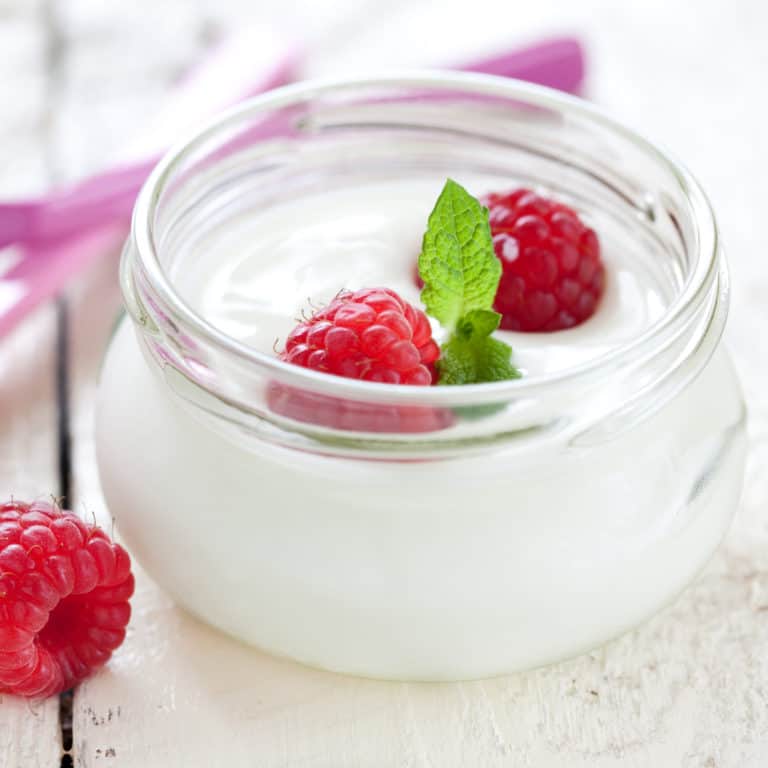
How to Make Yogurt
Let’s get started!
IF USING A STOCK POT INSTEAD OF A SLOW COOKER: If you’re in a hurry or don’t have a slow cooker you can use a stock pot. Simply heat the milk in a large stock pot over low to medium heat. Just be sure to stir it regularly, especially as it gets hotter, to prevent the milk from scorching. Then follow the rest of the instructions as written.
Pour the milk into the slow cooker and set it to HIGH. Go about your business, it’ll take at least 2 hours (usually longer) before the temperature’s up to 180 degrees. Use a thermometer to check the temperature.
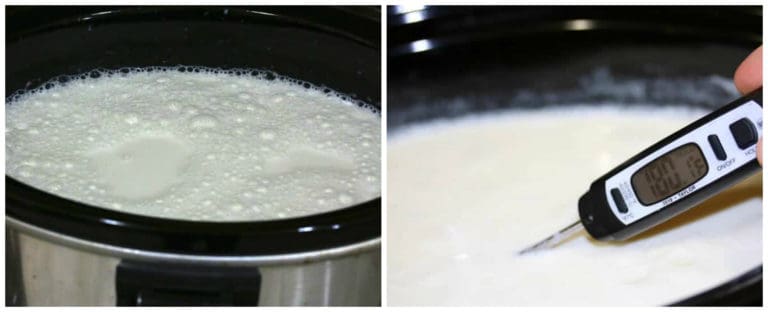
Once the temperature is up to 180 degrees, turn off the slow cooker or stove top and let the milk cool to 110 degrees F. Again, go about your business, this will take at least another 2 hours.
Once the temperature is 110 degrees, mix a little of the warm milk into the room temperature starter yogurt, then gently but thoroughly stir it back into the milk using up and down, left and right motions (not circular). Close the lid and turn off the slow cooker.
Wrap a large bath towel around the slow cooker and let it sit undisturbed in a draft-free, room temperature (or warmer) area for 10-12 hours or overnight. If the environment is too cool the yogurt will not set.
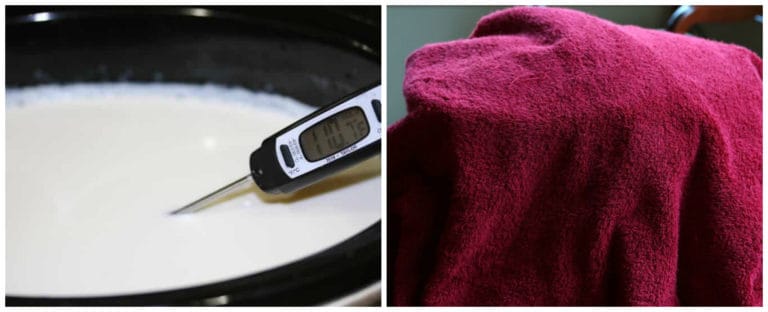
When you remove the lid you’ll find that the milk has thickened and the whey has separated.
Look at that fabulous thick texture! The transformation is almost magical. You’ll be so excited the first time you make this! I still get excited every time I lift the lid.
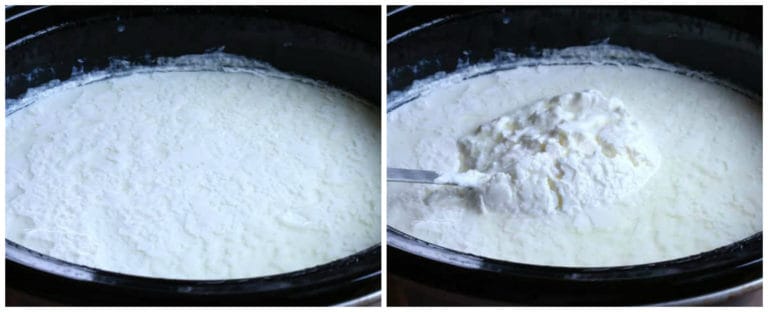
Line a colander with some cheesecloth.
I currently use this cheesecloth. It’s great quality and you get a lot of it for an excellent price.
Pour the yogurt into the cheesecloth. If it doesn’t all fit (depending on the size of your colander), let the yogurt strain until there’s room enough to add the remaining yogurt, then continue to strain.
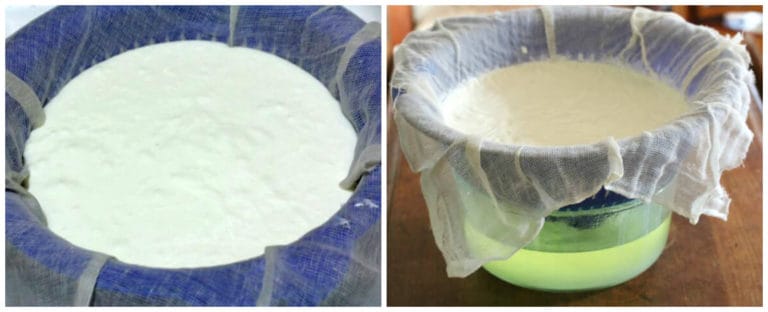
Depending on how thick you want the yogurt, this will take several hours. For thick Greek yogurt, you’ll end up straining it for at least 4 hours. That will also depend on the gauge of the cheesecloth. Set the colander on top of a large glass bowl. If leaving it to strain for several hours, you can put it in the fridge if you prefer and let it strain there.
See the liquid in the glass bowl above right? That’s whey. See the section “How to Use Whey” for ideas.
Store the yogurt covered in the fridge for up to 2 weeks. When you’re ready to make another batch, use some of the previous batch for the starter culture.
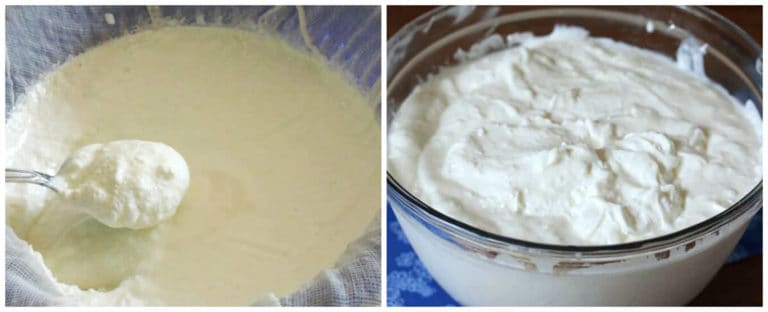
If fully strained to make Greek yogurt, you’ll end up with about 2 quarts (8 cups) of whey and 7-8 cups of Greek yogurt.
You’ll end up with less whey and more yogurt if you strain it less to make regular yogurt.
Cook with it, bake with it, eat it plain or with a variety of mix-ins, whatever your heart desires!
Enjoy!
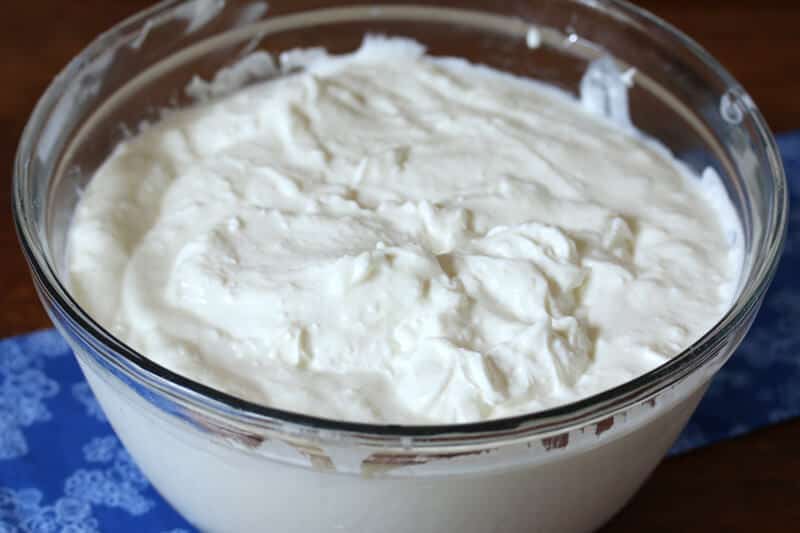
Be sure to also check out my tutorials on how to make:
Save This Recipe
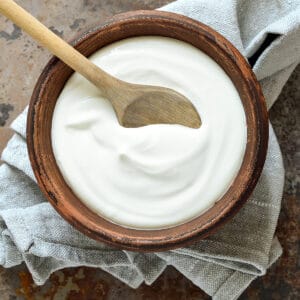
How To Make Yogurt
Ingredients
- 1 gallon whole milk, 2% or skim milk (whole milk is recommended for thickest, creamiest results) (see note about using raw milk) *this method does NOT work with non-dairy alternatives
- 1 cup plain yogurt at room temperature, either from previous batch or store-bought (**The yogurt must have live cultures in it to work. Check the ingredients to make sure they include l. bulgaricus and s. thermophilus.)
- Equipment:
- Slow cooker or Pot
- Thermometer
- Cheesecloth
- Colander
Instructions
- IF USING A STOCK POT: If you're in a hurry or don't have a slow cooker you can use a stock pot. Simply heat the milk in a large stock pot over low to medium heat. Just be sure to stir it regularly, especially as it gets hotter, to prevent the milk from scorching. Then follow the rest of the instructions as written.IF USING A SLOW COOKER: Pour the milk into a slow cooker set to HIGH and close the lid. It will take 2-3 hours before the temperature of the milk is up to 180 degrees F. Check it with an instant-read thermometer. Once it's at 180 degrees, turn off the slow cooker, close the lid, and let the milk cool to 110 degrees F. This will take another 2-3 hours. Once the temperature is between 110 and 115 degrees F, add some of the warm milk to the plain yogurt, stir to combine, and then gently but thoroughly stir the mixture back into the milk in the slow cooker using up and down, left and right motions (not circular).
- Close the lid, wrap the slow cooker or stock pot with a large bath towel, and let it sit undisturbed in a non-drafty place at room temperature (or warmer) for 10-12 hours or overnight. If the environment is too cool the yogurt will not set. During this process the milk will have thickened and the whey will have started separating from the milk.
- Line a colander with a cheesecloth and pour the yogurt into it. Set the colander over a large glass bowl and let it strain at room temperature for several hours, until you've achieved the desired thickness (length of straining time will also depend on the gauge of the cheesecloth. I use this cheesecloth – excellent quality and you get a lot of it for a great price) For thick Greek yogurt plan on at least 4 hours. You'll end up with about 8 cups of whey and 7-8 cups of Greek yogurt.
- Store the yogurt in the fridge in an airtight container, preferably a glass bowl for up to 2 weeks. When ready to make another batch of yogurt, use a cup of the previous batch as the starter culture.
Notes
**You don’t have to use the slow cooker method. For a quicker method simply heat the milk in a large stock pot over low to medium heat. Just be sure to stir it regularly, especially as it gets hotter, to prevent the milk from scorching. Then follow the rest of the instructions as written.
Nutrition
First published on The Daring Gourmet June 2017



















Beautifully explained!
CREAMIEST HOMEMADE YOGHURT EVER!
THANK YOU x
Fantastic, Ailene, thank you!
How could I forget the stars?!? ABSOLUTELY DELICIOUS!!!!
I haven’t made this yogurt since before Cov id and finished making it today. I love the crockpot method, it is SO EASY! It always comes out perfect! My starter was a 5.3 oz plain non-fat yogurt. I used skim milk and drained off 2qt + 1 cup of whey or 65 oz. The total amount of yogurt made was 1580 grams. I’m going to make non-fat cottage cheese with part of the whey and use the remainder to marinate meat.
Thank you so much for providing this recipe! The yogurt is super thick and delicious. I’d never be able to purchase this deliciousness in the store (at least not at a reasonable price! Blessings to you!
Yay!!! I’m so glad you enjoyed it, Melissa, thank you so much for the feedback! <3
AMAZING!!! I used half a gallon of whole milk as my slow cooker is not large enough for a gallon. I added one 6 oz container of plain yogurt after it cooled.
It took approximately 3 hours to heat and 3 hours to cool. (Keep checking as each cooker is different). I wrapped it in a small afghan and then covered it with my down jacket and left it overnight. It was still a little warm in the morning. (As a kid in Germany, my mother used to keep the potatoes warm under the feather blanket). I strained it for 3 hours. I am freezing the whey for later use. The result, I got 4 jelly jars (and a little extra) of the creamiest yogurt I could ever want. Having it with fresh strawberries later.
Fantastic, Christa, I’m so happy it was a success, thank you for the feedback!
My Instant Pot pressure cooker has a yogurt setting. It heats the milk and then keeps it at the right temp until the yogurt is done. Then I strain it for Greek yogurt. No brainer.
Just want to share…If you have an immersion circulator, you can make yogurt in any jars you have around in about 5 hours because water is more conductive of heat. Because the yogurt ferments quicker, it is less sour. Whatever starter yogurt you use is what it was taste like. We like chobani for this, and kalona dairy whole milk. I use 60g of starter for every 300ml of milk. Like this recipe, the starter is added after the yogurt has cooled from 180 to 110. For a gallon of milk in a stock pot, it takes about 20 minutes to get to 180 and 75 min to cool to 110. Then i add the starter yogurt and ladel into 16 oz jars (not mason jars, the lids rust) and sous vide at 110 for 5 hrs. There is no need to strain the yogurt afterwads, its pretty thick. The whey is a good source of protein, more digestible than casein. If i have it from making paneer from milk thats a hair sour, i drink it warm.
Thanks! I’m also using the immersion stick. Trying to figure out # of TBS of starter yogurt to oz of milk. I’m not so good w/ metric. What is 60 gm equivalent to in oz or TBS? TIA!
2 Tbsp. To a quart. 1 Tbsp to a pint.
Forgot the little stars!
You are probably the only person in the internet who can transform cooking hopeless people into chefs! Thank you for your recipes
That’s far too generous a compliment, Kingo, but I sure appreciate it, thank you! :)
I made this recipe and my yogurt turned out amazing!!! I did not strain it and the yield was almost a gallon of yogurt. This saves so much money! Thank you for sharing.
Fantastic, Felicia, thanks so much for the feedback!
Hello Kimberly!
Just wanted to say what an AMAZING recipe this is!
I come from a tropical country so left my yogurt-milk mixture sitting in the slow cooker on the kitchen bench overnight without bothering with wrapping a towel around it.
Strained it for around 5 hours to get Greek yogurt.
Amazing result.
Thank you! :)
Thank you, CT, I’m so glad it was a success!
I’ve made this yoghurt loads of times, I use my crock pot, and prefer Greek style yoghurt. It’s lovely and creamy and more than worth the long process.
Fantastic, Alison, thanks so much!
Can you use Oat or almond milk?
Hi Teresa, no, neither of those will work unfortunately. This method only works with regular milk.
Hello,
my milk has been in a slow cooker for around 5 hours and will only get to 100 degrees. I moved it to the stove and again I can only get it to 100 degrees.
Please advise why this is abd what I can do.
Sorry just to confirm it is 180 degrees Fahrenheit, which is about 82 celsius, are you using the correct one?
It’s great to get such detailed instructions, thank you. I’ll try that soon, if I have more time. In the meantime here is what I usually do: I am always short on time and like things to be fast and simple. I get (sorry all metric) a 1 liter carton of long life full cream milk and 3 small jars, dishwasher clean. From the shops I have a nice live yoghurt or the leftovers from my last batch. I put about 1 tablespoon in each jar, top up with milk at room temperature and stir it properly. Put the lid on and off it goes into my wall oven, which I heated up just a bit to ca. 40C (105F). I switch only the internal oven light on and this will keep the temperature around the 40C (only in winter I’d have to switch the oven temperature on high for 30 seconds every so often to maintain the 40C). After about 4 hours the milk has already turned to yoghurt, almost no whey. I put it in the fridge and have nice yoghurt for the next 2 weeks or so. After cooling down the consistency firms nicely. Using smaller jars keeps the unopened ones uncontaminated for longer shelf life. Long-life milk is already sterilized, and cheap. No more plastic waste. Cheap yoghurt. Only 2 minutes work per batch. No extra appliance needed. Taste can be varied, just start with a different yoghurt. Easy enough? :)
Hi Tony, would love to try your method, can I place jars in a slow cooker on warm?
Hi. I tried the slow cooker method, but was unable to get milk to 180°. I had milk in for 5 hours, it just turned very deep cream slightly brown colour. Lots of skim on top. Didn’t look good. Don’t think it will work? Any tips please? 😔
Its 180°F, which is about 82°C. Did you use the correct temperature?